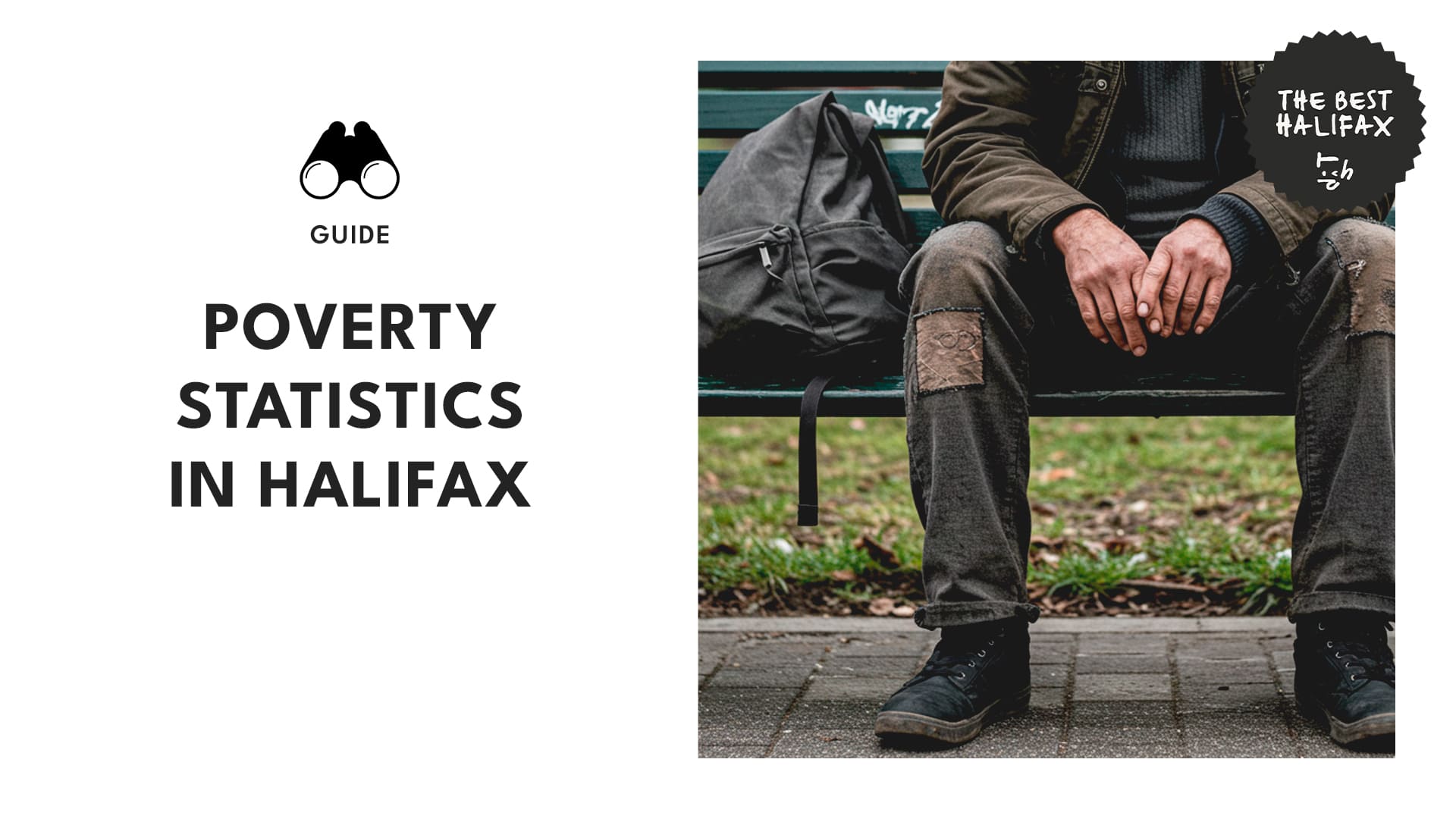- Key Insights
- Regional Analysis of Poverty Trends Across Canada
- Most Expensive Neighborhoods in Halifax
- Demographic Breakdown of Poverty Trends in Halifax
- Costs and Consequences of High Poverty Rates in Halifax
- Interventions and Solutions to Rising Poverty in Halifax
- The Future of Poverty Rates in Halifax
- References
Key Insights
| The Halifax Index 2024 reveals that Halifax’s poverty rate reached 13.6% in 2022, a 5.4-percentage-point increase from 2021. Nova Scotia and British Columbia registered the worst poverty rates at 9.8% in 2020, above the national average of 8.1%, according to the Canadian Poverty Census of 2020. The census further indicates that within Nova Scotia, the city of Halifax posted a 10.7% poverty rate, which was greater than the province’s overall average of 9.8%.Statistics Canada figures indicate that 12.9% of the 0-to-5-year-olds lived in poverty in 2020, the largest of any age category. A 2021 report by the Canadian Centre for Policy Alternatives put the annual cost of poverty to the province at around $2 billion, taking into account increased public health expenditure, additional criminal activity, and lost productivity. |
The Halifax Index 2024 shows that poverty continues to be an issue in Halifax, with the latest statistics indicating a steep increase in economic hardship.
Halifax’s poverty rate hit 13.6% in 2022, a 5.4-percentage-point rise over 2021 – the highest increase among benchmark cities.
This rise came against the backdrop of the withdrawal of pandemic-era economic support, leaving many families vulnerable to economic adversity.
The Halifax Market Basket Measure (MBM) threshold, or the amount of income required to be able to purchase basic goods and services, increased by $2,500 (4.8%) between 2022 and 2023 to just over $55,000.
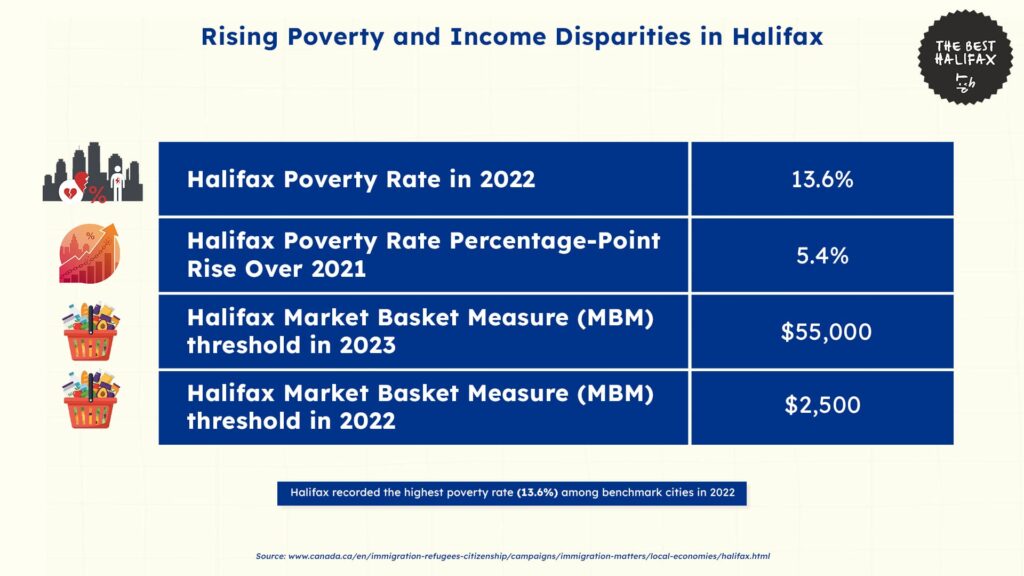
Data from Statistics Canada reveals that Halifax has 465,703 inhabitants, with a population makeup of 17% seniors (65+ years), 68% working-age persons (15–64), and 15% children (under the age of 15).
Meanwhile, the three primary sectors drive the economy of Halifax: health care and social assistance, retail trade, and public administration, which together represent 39% of employment in the region.
The economy of the city provides $27 billion in business and household incomes, which amounts to $58,557 per resident. These numbers indicate Halifax’s economic prowess but also point toward issues of income distribution and the cost of living.
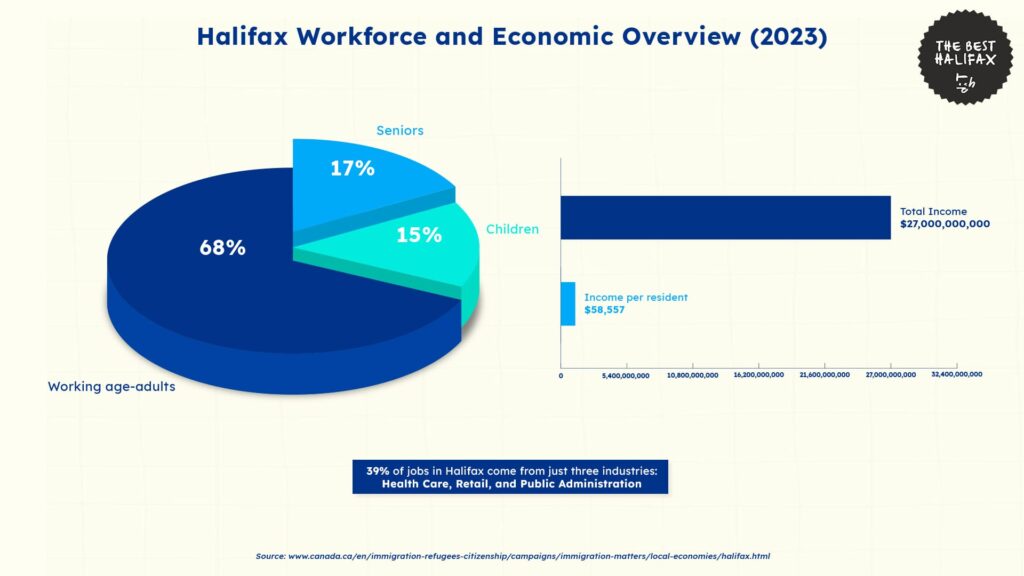
Although Halifax’s economy is bolstered by a strong workforce and core industries, population trends point to cultural difficulties.
The proportion of the working-age population (68%) is greater than the provincial average (64%), which enhances economic activity but also contributes to long-term concerns regarding an aging workforce.
Meanwhile, seniors (17%) represent a lower percentage than the provincial average of 22%. However, as this age group expands, the growing demand for healthcare and social services could place public resources under pressure.
The city’s robust employment situation is seen in strong employment levels, but income distribution is still unequal.
Total earnings stand at $27 billion, with an average per capita income of $58,557. Yet, there is still an unmet demand for affordability, with escalating housing and basic service costs continuing to be a strain.
The reliance of the city on a small number of core industries is also a concern in times of recession, emphasizing the need for diversification and development of new sectors.
Regional Analysis of Poverty Trends Across Canada
According to the Canadian Poverty Census in 2020, poverty rates in Canada show significant provincial variations.
Nova Scotia and British Columbia had the highest poverty rates at 9.8% in 2020 – higher than the national average of 8.1%. These statistics indicate economic issues of affordability, wages, and working conditions in these provinces.
Meanwhile, Quebec and Ontario had the lowest poverty rates at 6.4%, indicating more robust social programs, lower living costs in some areas, and greater access to affordable housing.
Among the Prairie provinces, Manitoba (8.6%) and Saskatchewan (8.4%) had slightly higher poverty rates than Alberta (8.1%), pointing to local economic differences across Western Canada.
In contrast, Prince Edward Island (8.7%) and New Brunswick (8.1%) were similar to the Canadian average, illustrating that economic conditions are challenging but differed across Atlantic Canada.
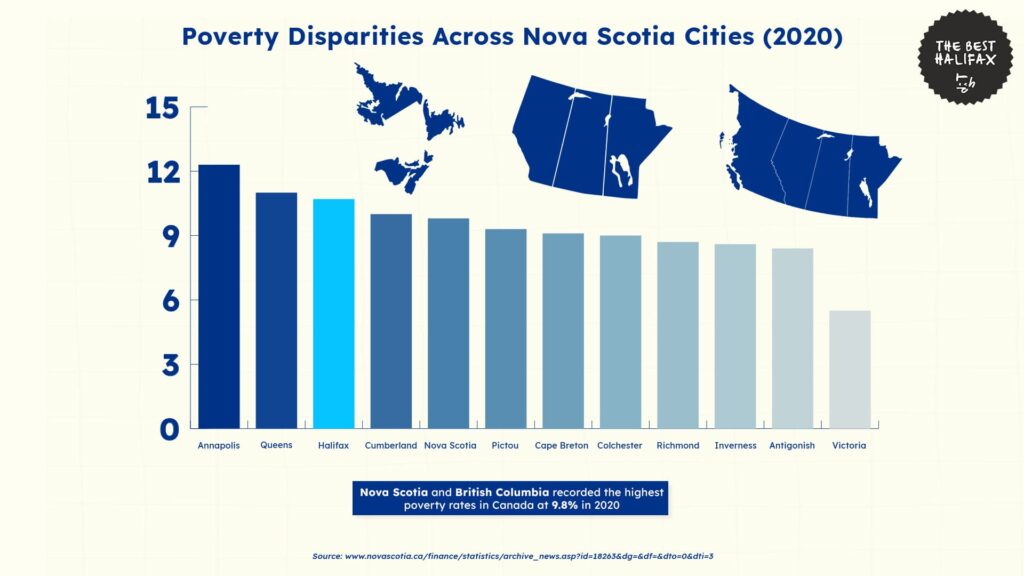
The census also shows that within Nova Scotia, poverty levels in the province differ substantially by city, with some rural cities facing greater financial distress.
Halifax, being the province’s largest urban municipality, had a poverty rate of 10.7%, higher than the provincial average of 9.8%. This follows a higher cost of living and associated housing affordability challenges in the city.
The highest poverty rates were seen in Annapolis (12.3%) and Queens (11.0%), which were even higher than Halifax at 10.7%.
These statistics reflect economic difficulties in smaller communities, where job opportunities and access to basic services might be more restricted.
Victoria County, on the other hand, was the lowest at 5.5%, indicating higher economic stability in the region.
The differences in the poverty rates among counties indicate that targeted economic development strategies need to be implemented in high-poverty regions, especially rural and semi-urban areas.
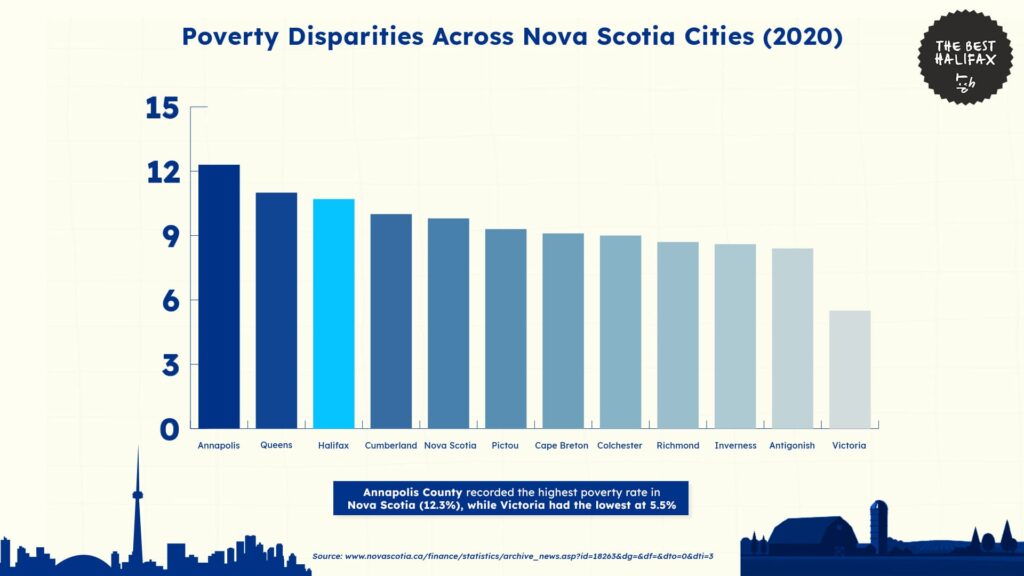
Most Expensive Neighborhoods in Halifax
AreaVibes gives insights to Halifax’s high-cost communities with cost of living well above the city norm.
The most costly communities are Point Pleasant Park, Beaufort Avenue South, and Jubilee Road. The cost of living here is higher by 40%, 35%, and 32% compared to the average index of 91 in Halifax, respectively.
These communities appeal to residents because they are close to amenities, have well-settled communities, and have access to quality education and transport.
However, the attractiveness of these neighborhoods has brought with it sky-high property values and rising housing prices, rendering them financially unaffordable for lower-income residents.
Meanwhile, South End Halifax, which is one of the city’s largest and priciest regions, boasts a cost of living index 20% above the Halifax average. This indicates the widening gap between higher-income and lower-income residents.
With few affordable housing opportunities in high-demand neighborhoods, most poor individuals and families have no choice but to find housing in lower-cost but typically under-resourced areas.
Consequently, people who are already struggling to sustain basic needs find themselves under increased financial strain, further worsening Halifax’s poverty level.
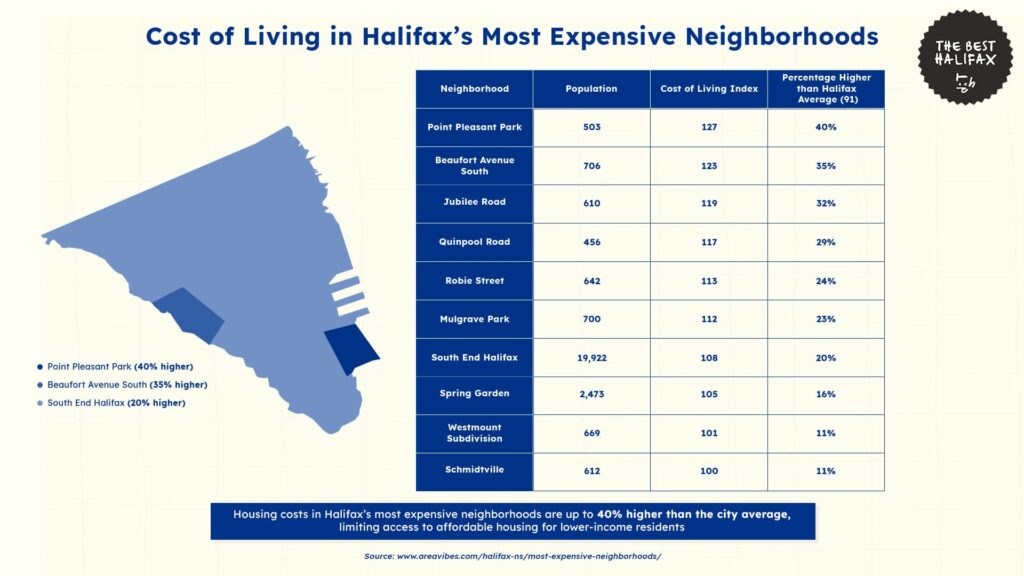
Demographic Breakdown of Poverty Trends in Halifax
Data from Statistics Canada reveals how poverty trends disproportionately impact families and individuals living alone across different age groups.
Poverty by Age Group in Economic Families
Halifax poverty rates vary widely by age, with young children and young adults experiencing the greatest poverty levels.
In 2020, 12.9% of children aged 0 to 5 years old were living in poverty, the highest of all age groups. Children aged 6 to 17 had a poverty rate of 10.9%, which means that close to one in ten children in Halifax lived in poverty.
Moreover, young adults between 18 and 24 years have a poverty rate of 8.7%, indicating difficulties in finding stable jobs and coping with increasing living expenses.
Of working-age adults, 6.5% of those between 25 and 54 were poor. Meanwhile, this rate fell to 4.1% for those between 55 and 64.
On the other hand, seniors aged 65 and above had the lowest poverty rate at 2.3%, primarily because of government pension schemes and retirement savings.
However, even though they had a lower poverty rate, seniors had a mean poverty gap ratio of 19.8%, which means that those who were poor had incomes considerably below the poverty line.
The poverty gap was even greater among younger age ranges. Children aged 6-17 had a poverty gap rate of 35.3%, and young adults aged 18-24 had a gap rate of 34.1%, indicating that individuals in poverty had significant income deficiencies.
These rates indicate the financial susceptibility of the younger populations, especially for those moving into the workforce.
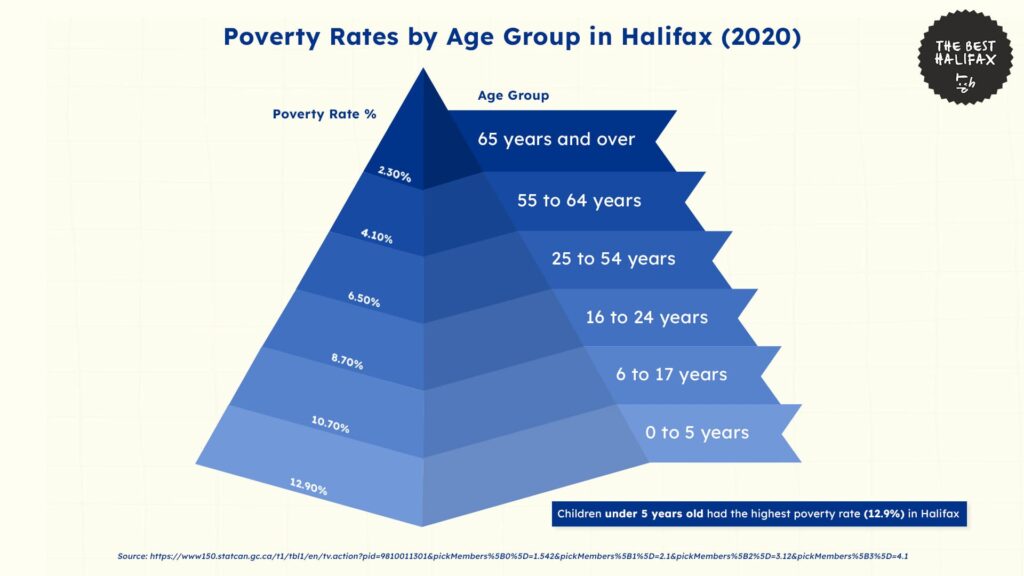
Poverty by Age Group Among Individuals Living Alone
The data also revealed that those who lived alone in Halifax had much higher poverty rates than those in economic families.
In 2020, 20.2% of those living alone were in poverty, almost three times the poverty rate of those in economic families (6.9%).
The economic burden was particularly harsh for young adults, with 45.8% of those aged 18 to 24 living alone in poverty. This implies that a lot of young people are grappling with expensive living, insecure employment, and low wages to sustain basic needs.
Middle-aged individuals also experienced severe financial difficulties. Of people aged 25 to 54 living in isolation, 18.7% lived in poverty, whereas those between 55 and 64 years of age had an even higher poverty rate at 27.9%.
The economic vulnerability of elderly persons with no family support was also visible, with 13.7% of seniors aged 65 and above living alone being poor.
Although government pensions offer some protection, the economically vulnerable ones were those with no other income sources. This is reflected in the poverty gap ratio of 20.0% among the living-alone seniors.
The information also reveals that not only were individuals who lived alone poorer, but also that they had more profound economic deficiencies.
The overall poverty gap ratio for all who lived alone stood at 36.7% against 34.6% for those living in economic families.
Among youth, this widened further to 47.6% for ages 18-24 and 40.9% for those in the age bracket of 25-54, reflecting how pronounced the income deficiencies of independent residents were.
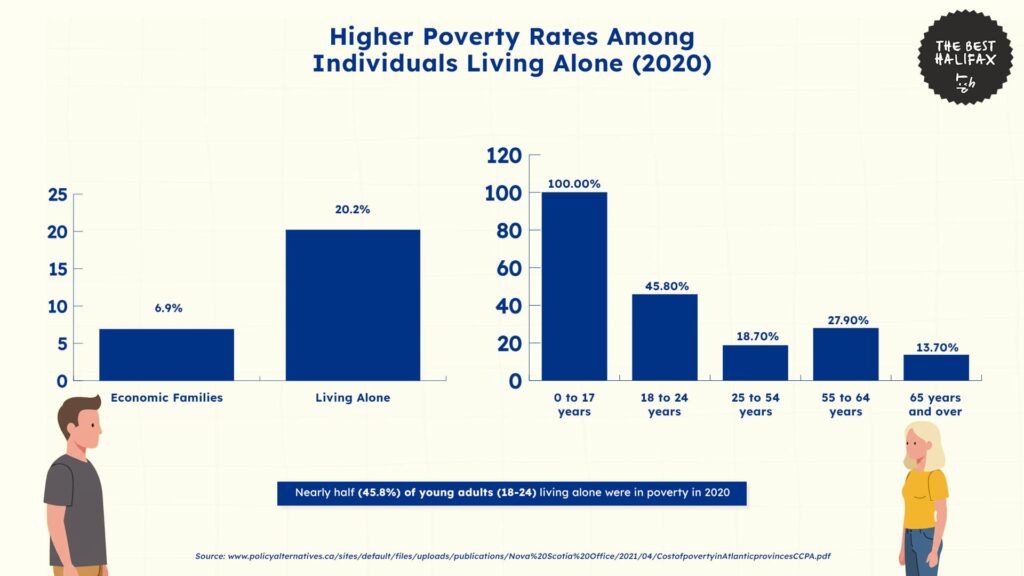
Costs and Consequences of High Poverty Rates in Halifax
A 2021 Canadian Centre for Policy Alternatives report estimated the cost of poverty to the province at about $2 billion a year, considering added public health spending, additional crime, and lost productivity.
Health care is one of the most expensive costs, as poorer individuals are more likely to have chronic illnesses and mental illnesses.
Inadequate access to healthy food, decent housing, and preventive treatment causes more emergencies and long-term health care, which puts greater pressure on the healthcare system in the province.
Crime-related costs are another important consideration. Financial difficulty is correlated with increased crime, as economic uncertainty contributes to increased possibilities of property offenses, drug abuse-related crimes, and other types of illegal conduct.
This yields higher law enforcement, court system, and prison expenditures. Targeted investment in poverty alleviation programs, such as subsidized housing and social welfare, might reduce crime rates and alleviate costs put on the justice system.
Lost productivity is also an added expense of poverty, as individuals from low-income families are confronted by barriers to continuous employment. These constraints shrink the labor pool and impede economic growth.
If individuals have difficulties in gaining employment or retaining their jobs, revenue from taxes lessens, and consumer spending decreases. This, in turn, impacts businesses as well as public services.
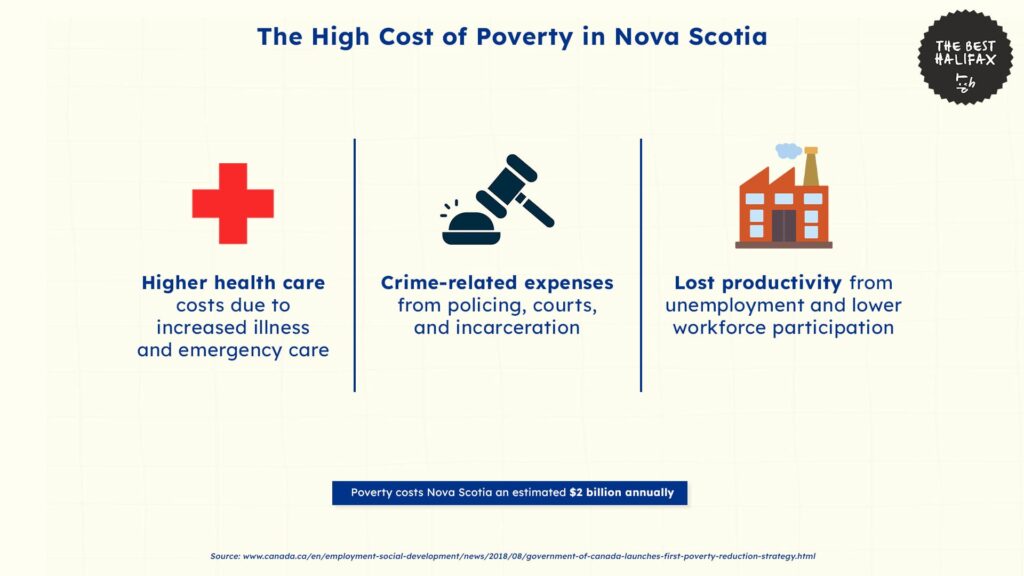
Interventions and Solutions to Rising Poverty in Halifax
Poverty in Halifax and Nova Scotia needs to be addressed through a multidimensional strategy encompassing government programs, community collaboration, and specialized support initiatives.
Federal and provincial policies have been put in place to alleviate poverty and foster social and economic integration.
The Government of Canada introduced its initial Poverty Reduction Strategy, “Opportunity for All,” in 2018. This program aims to curb poverty by 20% in 2020 and 50% in 2030.
This all-comprehensive strategy centers on three central pillars: dignity, opportunity and inclusion, and resilience and security.
Some of the central initiatives under the strategy are the Canada Child Benefit, the Canada Workers Benefit, and the National Housing Strategy, all of which offer monetary support and affordable housing to low-income Canadians.
Furthermore, in Nova Scotia, the Poverty Reduction Credit (PRC) offers financial aid to low-income individuals who are childless. Qualified recipients get $125 every quarter, or $500 a year, to ease financial burdens.
The province also created a Poverty Reduction Working Group to formulate recommendations for a holistic poverty reduction strategy, focusing on sustainable support, equity, and social justice.
Meanwhile, targeted programs for housing, education, and employment are also essential in alleviating poverty.
The National Housing Strategy will see more affordable housing provided while education and job training programs improve employability and income levels for the poor.
Through the integration of federal efforts, provincial efforts, community collaborations, and specific programs, Halifax and Nova Scotia can make substantial progress in alleviating poverty and creating a more inclusive society.
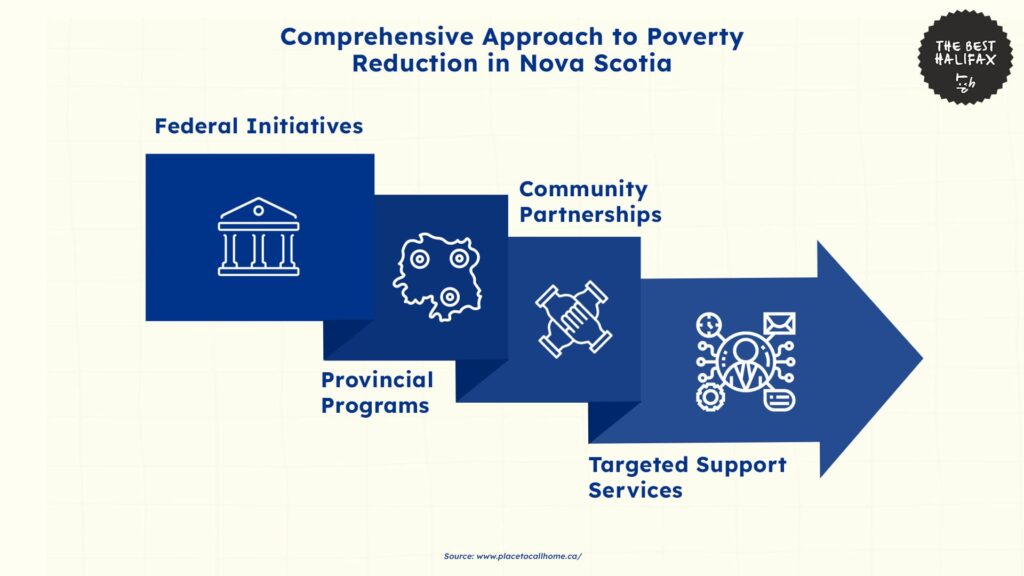
The Future of Poverty Rates in Halifax
Rising poverty rates in Halifax will continue to be a challenge as housing prices in high-demand regions are up to 40% more than the city average.
Without increased affordable housing programs, poverty levels are projected to remain above 10% over the next few years.
Income disparity may also continue, as the top 5% of earners saw a 20% income increase, while the bottom 50% experienced income declines.
Those who live alone will most likely continue to be the most at risk, with 20.2% already living in poverty. Increased living and healthcare expenses may further put pressure on seniors, especially on older individuals who only rely on pensions.
Increasing government support programs, job training, and wages may decrease poverty, supporting Canada’s aim to reduce poverty by 50% by 2030. Without more intervention, economic inequality may still increase.
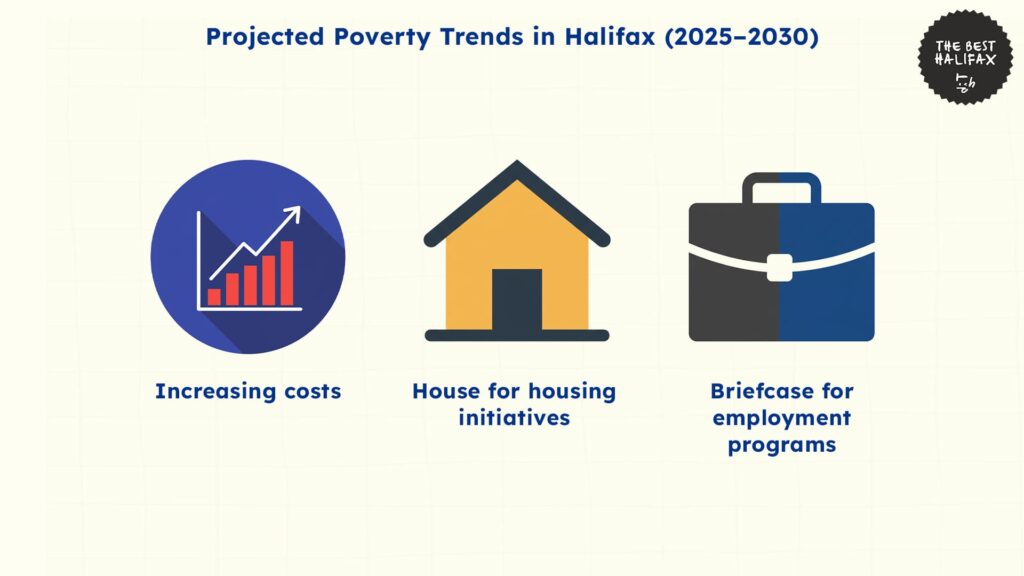
References
- Canada. (2018, August). Government of Canada launches first poverty reduction strategy. Government of Canada. Retrieved from https://www.canada.ca/en/employment-social-development/news/2018/08/government-of-canada-launches-first-poverty-reduction-strategy.html
- Canada. (n.d.). Immigration matters in Halifax. Immigration, Refugees and Citizenship Canada. Retrieved from https://www.canada.ca/en/immigration-refugees-citizenship/campaigns/immigration-matters/local-economies/halifax.html
- Conference Board of Canada. (n.d.). Conference Board of Canada. Retrieved from https://www.conference-board.org/ca
- Feed Nova Scotia. (n.d.). The cost of poverty in Nova Scotia. Retrieved from https://www.feednovascotia.ca/images/Cost_of_Poverty_in_Nova_Scotia.pdf
- Halifax Partnership. (n.d.). Halifax index: Affordability. Retrieved from https://halifaxpartnership.com/research-strategy/halifax-index/affordability/#:~:text=Poverty%20Rates%20by%20City&text=Halifax%20had%20the%20largest%20increase,had%20the%20lowest%20at%205.6%25.
- Nova Scotia. (n.d.). Poverty reduction credit. Government of Nova Scotia. Retrieved from https://novascotia.ca/coms/noteworthy/PovertyReductionCredit.html
- Nova Scotia Department of Finance. (2023). Statistics and news archive. Government of Nova Scotia. Retrieved from https://novascotia.ca/finance/statistics/archive_news.asp?id=18263&dg=&df=&dto=0&dti=3
- Place to Call Home. (n.d.). Canada’s national housing strategy. Government of Canada. Retrieved from https://www.placetocallhome.ca/
- Policy Alternatives. (2021, April). The cost of poverty in Atlantic provinces. Canadian Centre for Policy Alternatives. Retrieved from https://policyalternatives.ca/sites/default/files/uploads/publications/Nova%20Scotia%20Office/2021/04/CostofpovertyinAtlanticprovincesCCPA.pdf
- Statistics Canada. (n.d.). Table 98-10-0113-01: Income statistics by economic family type and age group. Government of Canada. Retrieved from https://www150.statcan.gc.ca/t1/tbl1/en/tv.action?pid=9810011301&pickMembers%5B0%5D=1.542&pickMembers%5B1%5D=2.2&pickMembers%5B2%5D=3.1&pickMembers%5B3%5D=4.1
- Areavibes. (n.d.). Most expensive neighborhoods in Halifax. Retrieved from https://www.areavibes.com/halifax-ns/most-expensive-neighborhoods/
